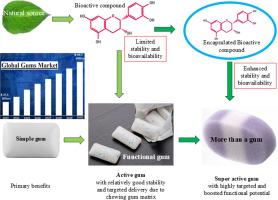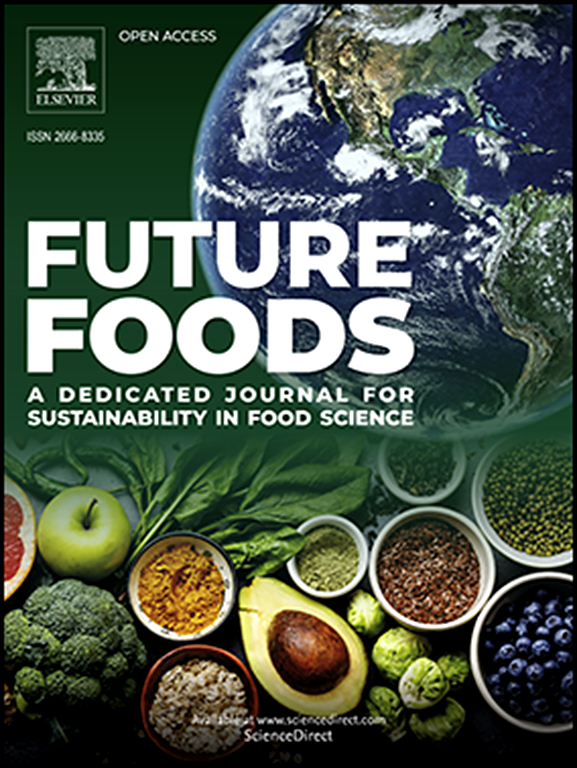Functional chewing gum: Transition from a conventional chew to a novel matrix delivering encapsulated bioactives with health-promoting properties
IF 7.2
Q1 FOOD SCIENCE & TECHNOLOGY
引用次数: 0
Abstract
Many studies have demonstrated the health and functional benefits of bioactive compounds (bioactives), as delivery of these ingredients to the body have been conducted by different techniques, such as enriched foods, supplements, etc. Among these, chewing gum (CWG) could be a unique candidate as delivery matrix of bioactives since presents some inherent benefits, including protective feature of its matrix as encapsulants; improving concentration, memory and alertness; stress reduction, weight manage, easy to use anytime and anywhere, and desired by consumers, especially children. Moreover, the specific style of CWG consumption, i.e. continued chewing without swallowing provides a unique opportunity to local and systemic delivery of bioactives in a sustained release manner, and the stability and activity of bioactives could be controlled by changes in the ingredients and manufacturing procedure, or using encapsulation technique. This review deals with introduction of bioactives in terms of chemical structure, health benefits, limitations for practical effectiveness, followed by highlighting the role of CWG as a delivery system of bioactives. Taking these into account, CWG composition and manufacturing procedures were reviewed, and developments in vitro delivery of encapsulated bioactives by CWG matrix were discussed. In this regard, more studies should be performed to monitor the release behavior of different bioactives from CWG as affected by various factors. Finally, further studies direct us to produce an optimum CWG formulation providing targeted outputs in line with consumer interests, namely good taste, practical efficiency, low price and lack of environment pollution.

功能性口香糖:从传统咀嚼口香糖过渡到新型基质,提供具有促进健康特性的封装生物活性物质
许多研究都证明了生物活性化合物(生物活性成分)对健康和功能的益处,并通过不同的技术,如强化食品、补充剂等,将这些成分输送到人体。其中,口香糖(CWG)可能是生物活性物质输送基质的独特候选者,因为它具有一些固有的益处,包括其基质作为封装剂的保护特性;提高注意力、记忆力和警觉性;减轻压力、控制体重;易于随时随地使用,以及消费者(尤其是儿童)的需求。此外,CWG 的特殊食用方式,即持续咀嚼而不吞咽,为生物活性物质的局部和全身持续释放提供了独特的机会,生物活性物质的稳定性和活性可通过改变成分和生产程序或使用封装技术来控制。本综述从化学结构、对健康的益处、实际效果的局限性等方面介绍了生物活性物质,随后重点介绍了化武颗粒作为生物活性物质递送系统的作用。考虑到这些因素,综述了 CWG 的成分和制造程序,并讨论了 CWG 基质体外递送封装生物活性物质的发展情况。在这方面,应开展更多研究,以监测不同生物活性物质受各种因素影响后从 CWG 中释放的行为。最后,进一步的研究将指导我们生产出最佳的 CWG 配方,提供符合消费者利益的目标产出,即口感好、实用高效、价格低廉和无环境污染。
本文章由计算机程序翻译,如有差异,请以英文原文为准。
求助全文
约1分钟内获得全文
求助全文
来源期刊

Future Foods
Agricultural and Biological Sciences-Food Science
CiteScore
8.60
自引率
0.00%
发文量
97
审稿时长
15 weeks
期刊介绍:
Future Foods is a specialized journal that is dedicated to tackling the challenges posed by climate change and the need for sustainability in the realm of food production. The journal recognizes the imperative to transform current food manufacturing and consumption practices to meet the dietary needs of a burgeoning global population while simultaneously curbing environmental degradation.
The mission of Future Foods is to disseminate research that aligns with the goal of fostering the development of innovative technologies and alternative food sources to establish more sustainable food systems. The journal is committed to publishing high-quality, peer-reviewed articles that contribute to the advancement of sustainable food practices.
Abstracting and indexing:
Scopus
Directory of Open Access Journals (DOAJ)
Emerging Sources Citation Index (ESCI)
SCImago Journal Rank (SJR)
SNIP
 求助内容:
求助内容: 应助结果提醒方式:
应助结果提醒方式:


